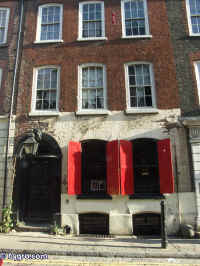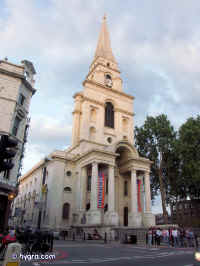Sewing
box Index

History of sewing
boxes
Request current
list of available sewing boxes
| |
Back to main page and details of a surviving sewing box with Spiers/ Dando
associations
| next picture| previous
picture |
slide show | thumbnail
index
from www.spiers.net/silk.htm
Charles Spiers 1795 – 1861
Modern London, published in
1888
The following is an extract from the
Modern London 1888.

Many of the houses in Spittle fields still display a
bobbin sign outside. This was used to indicate that there were silk
weavers occupying the house. The house above (detail) and below is 18
Folgate Street. It is at 18th century house in Spitalfields, London
created by the artist Dennis Severs. Open to the public who can
wander around the house in silence.
I first saw this house in the early 80s when Dennis Severs kept
song birds in cages outside the basement windows. I was not taking
photographs, but looking from across the road with a degree of natural
curiosity. Severs came out of the house shaking his duster in the air
not giving me a glance but hoping the dust of his performance would
assail my nostrils.


CHRIST CHURCH SPITALFIELDS
This picture was taken on the longest day of
the year as the light faded.
The Church was built/designed by Hawksmoor and completed in 1714.
See Hawksmoor
churches
|
Charles Spiers & Son, Hat Trimming
Manufacturer
Charles Spiers & Son, Hat Trimming Manufacturers, 18,
Union Street, Borough, S.E. - One of the most notable houses in London in
connection with the manufacture of hat trimmings is that of Messrs. Charles
Spiers & Son, a concern now under the sole control and proprietorship of Mr
Joseph Spiers, whose family have been associated with this business since the
close of the last century. In 1782 Mr Joseph Spiers’ great-grandfather came
from Leicestershire to London with a family of 17 children. The youngest of
these commenced business as a manufacturer of hat and other trimmings, all the
others working with him in the trade. At his death the oldest son continued the
business, and in 1810 he had two partners. The firm established a factory at
Halstead, in Essex, but owing to the existence at that time of an Act of
Parliament (soon afterwards repealed) forbidding any Middlesex manufacturer to
have a factory in any other county, an arbitary action was brought against the
firm, and its success necessitated the abandonment of the Halstead factory. The
business was removed to the Borough in 1812, and two years later the existing
partnership was dissolved. Mr Spiers, great-uncle of the present proprietor,
continued the business after that with the assistance of Mr Charles Spiers. In
1823 a removal was made to Church Street, Spitalfields, and the manufacture of
broad silk was commenced. This departure was followed in 1825 by the opening of
a factory at Chippenham, Wiltshire, where girls were taught winding, weaving,
&c., and this enterprise proved so successful that in a short time the
factory was filled with looms, throwing machinery, and other apparatus all in
busy operation. In 1830 the firm removed from Church Street to Steward Street,
Spitalfields, and the total number of hands then employed in the various
branches of the industry, including Chippenham, London, and a third factory at
Macclesfield, was no less than one thousand. In 1838 the concern was wound up,
and Mr Charles Spiers continued on his own account, retaining the Chippenham
factory as the principal industrial centre. He died in 1868, and was succeeded
by his son, Mr Joseph Spiers, the present head of the house. The headquarters of
the business are now in Union Street, Borough, (Southwark) where the premises
occupied comprise a large four- storey building, which affords excellent
accommodation.
At Chipenham the firm have a very extensive factory, and
carry upon a scale of much magnitude the manufacture of every description of hat
trimmings, all of which - including galoons, silks, and satins for linings,
leather linings, bands, &c.- are stocked at Union Street in large quantity
and comprehensive variety. The trade controlled is one of very great volume, and
is almost entirely confined in its effect to London, Lancashire, Glasgow, and
Bristol, supplying the silk hat makers of the metropolis and the felt hat
manufacturers of the Denton district. A large force of hands is employed, and
several travellers are also engaged in waiting upon the firm's influential
connections. Mr Joseph Spiers maintains the entire business and control of the
business himself, and the conspicuous prosperity of the house under his capable
administration stands as an ample and eloquent tribute to his personal resource
and judgement. Individually, Mr Spiers is highly esteemed by all who have
dealings with him, and his is a prominent name on the membership roll of the
City Liberal Club.’
|
‘
Authors notes -
Ron Spiers, Nov 2002
Note 1: Presumably the felt hat makers were at Denton 4
miles to the S.W. of Manchester.
Note 2: The addresses of the company were:
Halstead, Essex. (1810)
18 Union Street, Borough, Southwark, Surrey. (1812-88)
Church Street, Spitalfields, London. (1823)
Steward Street, Spitalfields, London. (1830)
10/11 Spital Square, London.
40 Gresham Street, London. (1872)
East Road, City Road, N, London. (1872)
3 Little Charlotte Street, Blackfriars Road, London. (1872)
Macclesfield, Cheshire. (1830)
91 Piccadilly, Manchester, Lancashire. (1873)
4 Aytoun Street, Manchester, Lancashire. (1862)
52 Glassford Street, Glasgow, Scotland. (1872)
Bridge Street,
Chippenham, Wiltshire.(1825-1889)
Back Lane, Chippenham, Wiltshire. (1877)
72 Farringdon Ave, London
E.C. (1901)
Note 3: Union St, Borough, Southwark, Surrey was at the
centre of the hat making area, and Union Street in 1860 was also part of the
‘old clothes’ district of Borough. Borough is across London Bridge on the
South side of the River Thames.
Note 4: Glassford Street, Glasgow is named after a
Glasgow tobacco merchant, it is the next street to Virginia Street, once the
home of Alexander Spiers, also a tobacco merchant. (see History item about
Alexander on Spiers.net). Trades House is in the street and is where merchants
traded.
Note 5:
It was common for silk weavers to work at looms
in their homes and it is not known how many of the thousand employees were
out-workers.
The author visited Chippenham which is in Wiltshire, to carry
out further research and found the following -
The Bridge Factory, Chippenham
The following is taken from Wiltshire and Somerset Woollen
Mills by Kenneth Rogers, Pasold Research Fund Ltd, 1976:
‘In 1796 Henry Burnet sold a leasehold house near the
Bridge to Thomas Goldney. He probably used this site to build a factory which
appears in the Chippenham rate of 1811, when it was described as a factory,
dye-house, and shearshops occupied by Thomas and Henry Goldney, members of a
family prominent in the clothing trade in the town since the sixteenth century,
In 1816 Goldneys employed 44 hands, but their business ended about two years
later. The factory became the property of Anthony Guy, a lawyer and banker who
was bankrupt in 1830. It was then offered for sale, having five floors 86ft by
25ft and worked by a steam engine. It was held by Joseph Spiers under a 21 year
lease made in 1825, and used as a silk factory. This firm, later Charles Spiers
and Son, remained in the same business in Chippenham until 1885, but probably
relinquished the Bridge Factory at the end of the lease in 1846. In 1839 they
had taken a lease of a factory in Timber Street. The Bridge Factory was
susequently used for the storage of hides until it was taken over by the
National Anglo-Swiss Milk Co., in 1873.
The building was susequently used by Nestles as a milk
factory and was pulled down in 1937. It was a rubble stone building of four
storeys plus attics in a mansard roof at one end and five storeys at the other,
of nine bays with two light stone-mullioned windows with flat heads. The five
storey part was perhaps an extension of 1813, when the rateable value of the
factory doubled, and as the steam engine was at that end, the use of steam power
probably dates from then, the other part (probably of 1796) being perhaps worked
by horses.
The design of the building was almost identical with the
nearby town corn mill. The chimney-stack was inside the building on the river
side, square in section and unusually short, only rising a few feet over the
eaves level. In 1827 Hadens fitted steam pipes to warm the mill, and pipes to
supply water to closets on each floor.’
With the help of other researchers the author has compiled a family tree of
this Spiers family.
Author – Ron Spiers, Nov 2002
www.spiers.net/silk.htm
News
| Buying
| email | Online
History of boxes | The
Schiffer Book |
Request
current list of available sewing boxes.
All text and images and linked images are ©
1999-2006 Antigone Clarke and Joseph O'Kelly. If you require any further
information on permitted use, or a licence to republish any material, email us
at copyright@hygra.com
|
